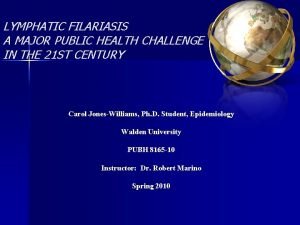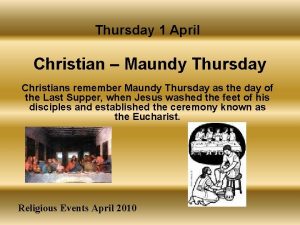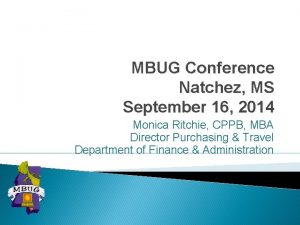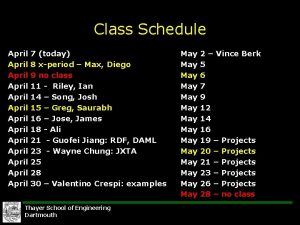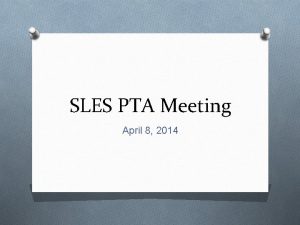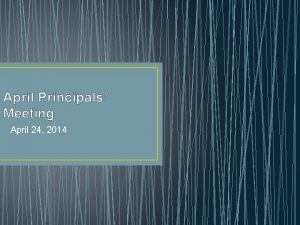LAMSSRS Stateline Meeting April 15 16 2014 Natchez








- Slides: 8

LA-MS-SRS State-line Meeting April 15 -16, 2014, Natchez, MS “Opportunities”

Opportunities – General 1. Communicate information to land managers and forest landowners 2. Establish a means of sharing research needs and concerns with SRS and states Opportunities –Forest Sustainability 1. Develop a paper defining the difference/purpose of For. Warn vs. the Forest Health Program’s tool. Perhaps see if there can be a “one-stop-shop” for these applications. 2. Continue developing applications for use by field practitioners, forest managers. Need the auto detect and notify. 3. SGSF GIS committee can play a role in identifying needs for additional applications. 4. Share info on how to use For. Warn via webinars made available to the states – especially the state GIS people.

Opportunities – Forest Health 1. There is a continuing need for detection and monitoring. Will emerald ash borer continue to move south? The sirex woodwasp? 2. Look for opportunities to leverage – i. e. get longleaf group’s support in reducing cogon grass. It’s more than just putting longleaf in the ground – it’s about the whole ecosystem. 3. Is there a way to convey information to policy-makers and legislators to garner support for invasives treatment as a part of the longleaf effort. 4. We really need a silver bullet for cogon grass. 5. S&PF competitive grants? Maybe when the states are developing their proposals, they can connect with SRS scientists to identify ways to leverage efforts. 6. Same with information and education – there needs to be continuing emphasis on communicating with landowners in regard to this type of information. Recognize that while social media is popular for newer generations, the older people still like something more personal.

Opportunities – Silviculture 1. 2. 3. 4. Find a way to map LLP across the south. What information can FIA provide to assist? Is there a way to identify stands that are partly LLP, that can be thinned to restore the LLP? Is there information that can be developed to promote restoration of LLP, integrating the myriad of interests/concerns such as markets, invasives, social values, ecological values, and importance of fire management. Getting this information together in written form to the family landowners is key. 5. It is feasible to have shortleaf-loblolly stands that emulate LLP and promote the same values. 6. What ways can the options be shared with private landowners (i. e. marketing)? What other ways are there to help emphasize how important forest resources are to economies in LA & MS. 7. What about involving architects and other non-traditional groups more in the discussion about quality of wood products? What are the connections for these people?

Biomass Opportunities 1. Share information with operators to help them understand the importance of feedstock quality, keeping dirt off and minimizing ash content. 2. Continue to share information about equipment available for getting different types of product out of the forest most efficiently. 3. Finish development of the guide that provides information on the chemical properties with the production based on different feedstocks, etc. 4. Continue to provide FIA data to companies that are considering moving into the area, so they know what material is out there for their use.

Fire/Smoke Opportunities 1. Continue to communicate with the public about the role of prescribed fire across the landscape, and the implications of unmanaged wild fires. 2. Concern about the lack of smoke management in the agriculture industry. Need for increased communication, cooperation with agricultural landowners regarding burning on ag lands. 3. Continue to involve partners to help share the word about the value of burning as a sound ecosystem management need (e. g. benefits to wildlife). 4. States can continue to promote the value of prescribed fire through marketing, ad campaigns, in order to help improve public perception

Water Opportunities 1. Continue to emphasize how important clean water is to society. Utilize the assessment that SRS developed for the Southeast U. S. as a tool to help understand where the source of clean water is and where it is used by society. In the South 50% of people get their water from forests – and most of the forests are in private landownership. 2. Continue/increase evaluation of economics of water as an ecosystem service. 3. Increase integration with land planners in regards to development impacts on water quality, quantity and aquatic ecosystems. 4. Continue to scale up and help people understand implications across larger landscapes 5. Possibly include water as part of Piney Woods project.

Next Steps: May 2014: LA and MS State Foresters and SRS Station Director will prioritize opportunities and identify who/what/when for moving forward with specific actions.






